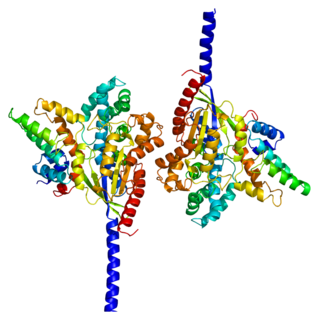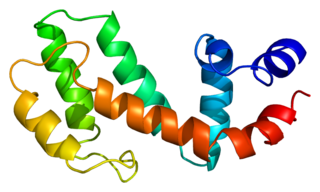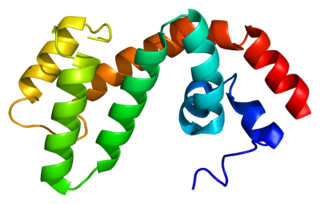
Regulator of G protein signaling 4 also known as RGP4 is a protein that in humans is encoded by the RGS4 gene. RGP4 regulates G protein signaling.

Regulator of G-protein signaling 2 is a protein that in humans is encoded by the RGS2 gene. It is part of a larger family of RGS proteins that control signalling through G-protein coupled receptors (GPCR).

Guanine nucleotide-binding protein G(i), alpha-1 subunit is a protein that in humans is encoded by the GNAI1 gene.

GIPC PDZ domain containing family, member 1 (GIPC1) is a protein that in humans is encoded by the GIPC1 gene. GIPC was originally identified as it binds specifically to the C terminus of RGS-GAIP, a protein involved in the regulation of G protein signaling. GIPC is an acronym for "GAIP Interacting Protein C-terminus". RGS proteins are "Regulators of G protein Signaling" and RGS-GAIP is a "GTPase Activator protein for Gαi/Gαq", which are two major subtypes of Gα proteins. The human GIPC1 molecule is 333 amino acids or about 36 kDa in molecular size and consists of a central PDZ domain, a compact protein module which mediates specific protein-protein interactions. The RGS-GAIP protein interacts with this domain and many other proteins interact here or at other parts of the GIPC1 molecule. As a result, GIPC1 was independently discovered by several other groups and has a variety of alternate names, including synectin, C19orf3, RGS19IP1 and others. The GIPC1 gene family in mammals consisting of three members, so the first discovered, originally named GIPC, is now generally called GIPC1, with the other two being named GIPC2 and GIPC3. The three human proteins are about 60% identical in protein sequence. GIPC1 has been shown to interact with a variety of other receptor and cytoskeletal proteins including the GLUT1 receptor, ACTN1, KIF1B, MYO6, PLEKHG5, SDC4/syndecan-4, SEMA4C/semaphorin-4 and HTLV-I Tax. The general function of GIPC family proteins therefore appears to be mediating specific interactions between proteins involved in G protein signaling and membrane translocation.

Guanine nucleotide-binding protein G(z) subunit alpha is a protein that in humans is encoded by the GNAZ gene.

Regulator of G-protein signaling 16 is a protein that in humans is encoded by the RGS16 gene.

Regulator of G-protein signaling 19 is a protein that in humans is encoded by the RGS19 gene.

Guanine nucleotide-binding protein subunit beta-5 is a protein that in humans is encoded by the GNB5 gene. Alternatively spliced transcript variants encoding different isoforms exist.

Regulator of G-protein signaling 7 is a protein that in humans is encoded by the RGS7 gene.

Regulator of G-protein signaling 1 is a protein that in humans is encoded by the RGS1 gene.

Regulator of G-protein signaling 20 is a protein that in humans is encoded by the RGS20 gene.

Regulator of G-protein signaling 12 is a protein that in humans is encoded by the RGS12 gene.

Regulator of G-protein signaling 14 (RGS14) is a protein that in humans is encoded by the RGS14 gene.

Regulator of G-protein signaling 18 is a protein that in humans is encoded by the RGS18 gene.

Regulator of G-protein signaling 8 is a protein that in humans is encoded by the RGS8 gene.

Regulator of G-protein signalling 9, also known as RGS9, is a human gene, which codes for a protein involved in regulation of signal transduction inside cells. Members of the RGS family, such as RGS9, are signaling proteins that suppress the activity of G proteins by promoting their deactivation.[supplied by OMIM]

Regulator of G-protein signaling 6 is a protein that in humans is encoded by the RGS6 gene.

Guanine nucleotide-binding protein G(k) subunit alpha is a protein that in humans is encoded by the GNAI3 gene.

Regulator of G-protein signaling 13 (RGS13) is a protein that in humans is encoded by the RGS13 gene.

Regulator of G-protein signaling 17 is a protein that in humans is encoded by the RGS17 gene.





























